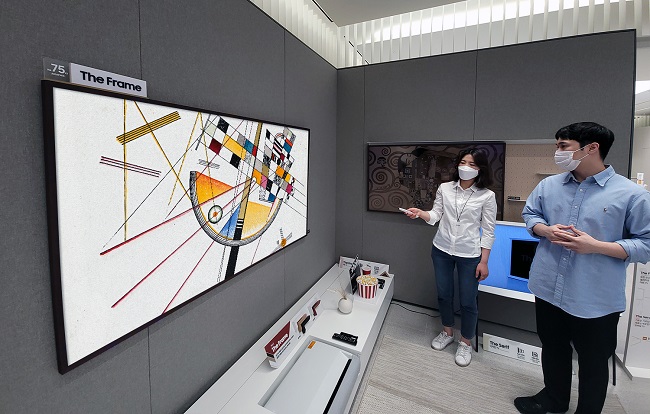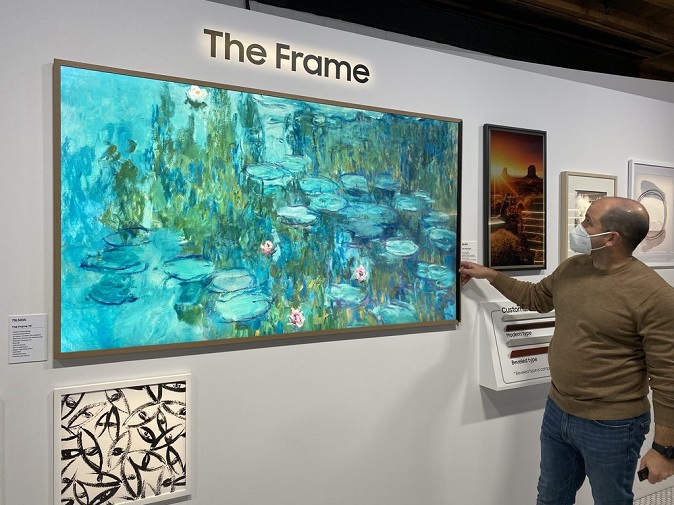
This photo provided by Samsung Electronics Co. on June 15, 2021, shows its Frame TV displaying Wassily Kandinsky’s “Delicate Tension No.85″ at a store in Seoul.
SEOUL, July 23 (Korea Bizwire) — A television is often dubbed as a magic box, as it shows almost everything on the planet, but in the era where staying at home became the new normal amid the pandemic, it has become more than just a screen.
With movies, TVs can turn your home into a cinema, and with video games, they can make your living area an amusement arcade. When TVs show fitness content, your home suddenly becomes a gym.
As TV’s role of redefining people’s living space grows in the pandemic era, electronics makers are now aggressively promoting TVs as devices that can also transform your home into a private art gallery.
Buoyed by the contactless trend, TV manufacturers are bringing more renowned paintings to their products by expanding partnerships with the art community.
Samsung Electronics Co., the world’s largest TV vendor, last month added 23 well-known modern artworks, including paintings from Piet Mondrian and Wassily Kandinsky, to its art subscription service after collaborating with the Thyssen-Bornemisza National Museum in Madrid.
Today, Samsung’s Art Store catalogue offers more than 1,500 art pieces from 626 artists from 42 countries, covering everything from ancient art to contemporary art.
The Art Store was launched in 2017, but with the pandemic-induced lockdowns, Samsung says demand for such art exhibition services is getting a boost.
“With COVID-19 changing our daily lives, it’s true that people’s screen time has increased” said Seline Han, deputy head of the TV service business team at Samsung’s visual display division.
“I think there is an increased need to decorate their private space, while the value of artwork also increased as it can soothe the minds and emotions of people amid the pandemic.”

This photo taken Jan. 12, 2021, shows Samsung Electronics Co.’s lifestyle TV, The Frame, displayed at Samsung 837 center in New York. (Yonhap)
The Art Store is currently exclusively available on its lifestyle TV, The Frame, but Samsung hinted that the service could be expanded to its other TV models in the future.
“The owners of The Frame spend more time using the product as an art screen rather than watching TV, so we believe the concept is delivered well,” Han said.
“We plan to reinforce the Art Store experience as we see that people’s interest in art and culture is growing steadily.”
Collaboration with the art community is not a new marketing program for TV makers.
But such a marketing tool is more frequently used these days as TV makers come up with advanced display technologies to show artwork in enhanced picture quality, according to Ju Byeong-kwon, an electrical engineering professor at Korea University.
“What’s really important for these companies is whether their TVs can accurately deliver the paintings as we see them with our own eyes,” Ju said.
“Of course, it is difficult for display products to exactly express original paintings 100 percent, but with the latest 8K resolution and color gamut coverage solutions, I think such art services are worth using.”
With improved display solutions, the concept of TVs-as-art frames is also getting help from the art community as it allows artwork to be shown in various channels beyond offline.
“Art centers and museums are opening their data and collections, and that’s now a global trend,” said Sun Seung-hye, director of the Daejeon Museum of Art. “Both online and offline are important for the art community, and it is our job to seek a win-win solution.”

This photo provided by LG Electronics Inc. on July 4, 2021, shows models looking at the company’s OLED TV showing local artists’ paintings on its OLED Gallery app.
Those who welcome TV makers’ art exhibition services said it gives artists more opportunity to promote their work in an easier and more efficient way.
“Promoting their artwork on social network services (SNS) has its limitations, because people have to see them through smartphones with small screens,” said Lee Won-jun, who runs the online art streaming platform Patron Digital.
“There is a big quality difference when smart TVs show paintings on a larger screen.”
To better support the art community in the pandemic era, TV makers are now focusing on not only showing masterpieces from famous artists but also from new and unknown artists.
LG Electronics Inc., the world’s second-largest TV vendor, signed a partnership earlier this month with Polestar Art, a local art content provider, to showcase pieces of art from homegrown artists through its OLED Gallery app.
LG’s art streaming service is offered in 150 countries for those who have OLED TVs released in 2017 or later. It is also available on its premium LCD TV models produced after 2018.
“The OLED Gallery aims to become a global platform that can help creators and art providers to generate reasonable revenue,” said Jung Sung-hyun, who heads LG’s home entertainment service planning and operation.
“If talented South Korean artists can communicate with global audiences through LG’s smart TVs, we believe the local art community can also benefit from the K-Wave.”

This photo provided by LG Electronics Inc. on Dec. 3, 2020, shows its Signature OLED R TV displayed at the Pushkin State Museum of Fine Arts in Moscow.
As digital art services on TVs expand, some people worry that it may eventually diminish the role of art centers and museums, but those in the art streaming industry think that will not be the case.
“We found out that people who saw paintings of their taste on the art streaming service actually visit art centers later to enjoy the real piece of art,” said Lee Jae-hoon, the CEO of Polestar Art, who also runs an offline gallery in Seoul.
“Such an art streaming platform can lead to win-win growth, especially to small galleries that lack resources to promote their collections.”
Artists also agree that demand for offline art exhibitions will continue because there is still a big difference between viewing a piece of art through one’s own eyes and through a TV.
“Even if TVs come with ultrahigh definition screen resolution, they still cannot convey the texture of artwork,” Lee Eun-hwang, an artist in Western paintings, said.
“It’s a positive trend that smart TVs are making art familiar to people, but delivering the feeling of a real art piece is another matter.”
(Yonhap)






